
The grey-headed chickadee or Siberian tit is a passerine bird in the tit family Paridae. It is a widespread resident breeder throughout subarctic Scandinavia and the northern Palearctic, and also into North America in Alaska and the far northwest of Canada. It is a conifer specialist. It is resident, and most birds do not migrate. Curiously, the bird has no grey on its head, which is black, white, and brown.

The white-winged black tit is a passerine bird in the tit family Paridae. It is also known as the white-winged tit, dark-eyed black tit or northern black tit. The species was first described by Eduard Rüppell in 1840.
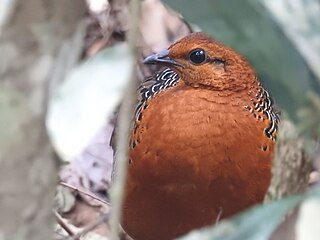
The ferruginous partridge is a species of bird in the family Phasianidae. It belongs to the monotypical genus Caloperdix. It is found in Indonesia, Malaysia, Myanmar, and Thailand.

The cinnamon-bellied imperial pigeon is a species of bird in the family Columbidae. It is endemic to the northern Moluccas. Its natural habitat is subtropical or tropical moist lowland forests.
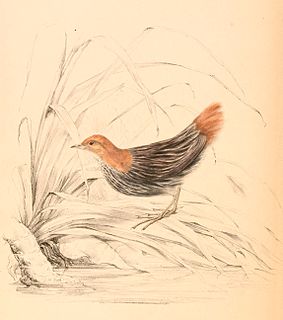
The striped flufftail is a species of bird in the flufftail family Sarothruridae. It is also known as the red-tailed flufftail. The species is closely related to the Madagascar flufftail. The species has a disjunct distribution across the Afromontane of southeastern Africa, with two subspecies. The nominate subspecies S. a. affinis is found in eastern South Africa and Swaziland. S. a. antonii, named for German ornithologist Anton Reichenow, is found in eastern Zimbabwe and Mozambique, Malawi, southern Tanzania, Kenya and the south of South Sudan.

Woodward's batis, also known as Woodwards' batis or the Zululand batis, is a species of small bird in the wattle-eyes family, Platysteiridae. It occurs in southeastern Africa where it is found in woodlands and forests.

The forest batis or short-tailed batis is a species of bird in the wattle-eye family, Platysteiridae occurring in eastern Africa.

The olive-green camaroptera is a bird species in the family Cisticolidae.

The white-bellied tit is a species of bird in the family Paridae. It is found in Cameroon, Kenya, Nigeria, South Sudan, Tanzania, and Uganda. Its natural habitats are subtropical or tropical dry forests and subtropical or tropical moist montane forests.

The elegant tit is a species of bird in the tit family Paridae endemic to the Philippines.

The stripe-breasted tit is a species of bird in the family Paridae. It is found in Burundi, Democratic Republic of the Congo, Rwanda, and Uganda. Its natural habitats are subtropical or tropical moist montane forests.

The miombo tit is a species of bird in the family Paridae. It is found in Angola, Democratic Republic of the Congo, Malawi, Mozambique, Tanzania, Zambia, and Zimbabwe. Its natural habitat is subtropical or tropical dry forests.

The southern black tit or simply black tit is a species of bird in the tit family Paridae, which is native to woodland habitats in southern Africa.
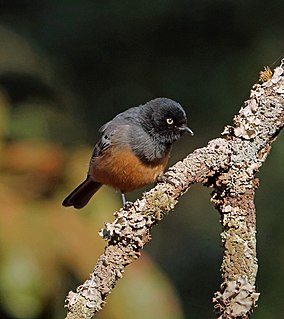
The rufous-bellied tit is a species of bird in the tit family.

The acacia tit, also known as the Somali tit and northern grey tit, is a species of bird in the family Paridae. It is native to north eastern Africa where it occurs in dry acacia habitat.
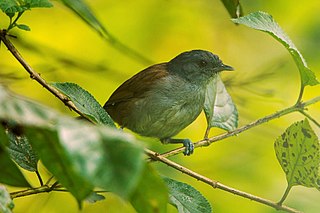
The African hill babbler is a species of bird in the family Sylviidae.

Poecile is a genus of birds in the tit family Paridae. It contains 15 species, which are scattered across North America, Europe and Asia; the North American species are the chickadees. In the past, most authorities retained Poecile as a subgenus within the genus Parus, but treatment as a distinct genus, initiated by the American Ornithologists Union, is now widely accepted. This is supported by mtDNA cyrochrome b sequence analysis.

Melaniparus is a genus of birds in the tit family. The species were formerly placed in the speciose genus Parus but were moved to Melaniparus based on a molecular phylogenetic analysis published in 2013 that showed that the members formed a distinct clade. The genus Melaniparus had originally been introduced by the French naturalist Charles Lucien Bonaparte in 1850. The type species was subsequently designated as the southern black tit. The name of the genus combines the Ancient Greek melas, melanos "black" and the genus Parus introduced by Carl Linnaeus in 1758.
Reichenow's batis is a passerine bird in the wattle-eye family, Platysteiridae occurring in southeast Tanzania in east Africa. It was formerly treated as a subspecies of the forest batis.
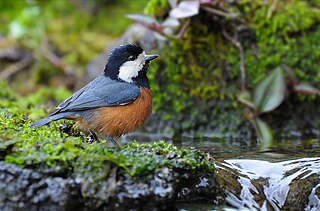
The chestnut-bellied tit is a small passerine bird in the tit family Paridae that is endemic to Taiwan.



















